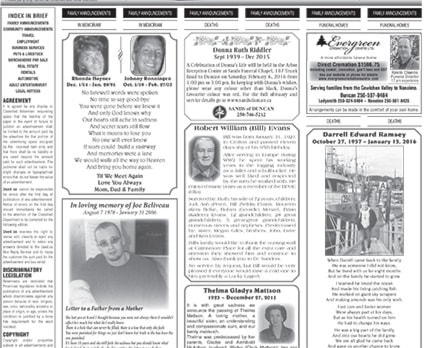A recent Canadian Press news story states that “The majority of Canada’s provinces and territories have been assigned high marks on a new report card for history education.”
The study, by Historica Canada, looked at both social studies and history curricula from grades 7 through 12 across the country.
I have my doubts about these findings but I’ll leave that for another day. Instead, I’d like to suggest to teachers that they make newspaper obituary columns an assigned homework project. If you want young Canadians to not just learn about but to really engage with Canadian history there’s no better way than teaching them about fellow Canadians who have made their marks, large and small but very tangibly, upon this planet.
Maybe not in ways that won for them fame and fortune, but in truly meaningful ways nonetheless. Even though their passing may have been of little note to “posterity” theirs are real losses to humankind of courage, character, compassion, integrity and ingenuity even if only their friends, families and co-workers were aware of their virtues and accomplishments.
To prove my point, I’m going to cite three examples from a single obituary page (well, three pages, actually) in the Jan. 23 Times-Colonist. Obituaries are depressing, you say? No, they’re awe-inspiring!
Let’s begin with Dr. Robert Douglas who passed away Jan. 13, aged 72. A keen basketball player who completed his MD at the University of Saskatchewan and went on to McGill University for his neurology residency, he “acquired encephalitis when working on the Children’s unit at Montreal Children’s Hospital”. Get this: “Against all odds he relearned to speak and walk again, and then went on to relearn his medicine and practiced for many more years in Montreal, Saskatchewan and B.C.”
Could children learn something from Dr. Robert Douglas’s astounding courage? You’re darned right they could!
The “headliner” of this issue of the T-C obits was Margaret Brooke, whose story I told you in the Citizen’s last Remembrance Day special edition. On her 100th birthday she was informed that the government was naming a new naval ship after her for her heroism in attempting to save the life of a fellow nurse after their ship was torpedoed during the Second World War. For which Margaret Brooke was awarded an MBE, then the highest honour that a woman could receive.
Could children learn something from, perhaps even be inspired by, Margaret Brooke?
Josephine Mirth Amber Doyle, 1913-1916, quickly showed her worth as a Saanich pioneer. Not back in the early frontier days, obviously, but in the hard ‘20s and ‘30s. Raised on a farm at Cadboro Bay, her childhood was that of daily chores and delivering milk by horse and cart. When her father was disabled, it was off to work as an underage servant at the Cadboro Bay Beach Hotel then back to helping on a larger family farm beside Elk Lake.
“They lived in tents for the first two winters, among the coldest on record. Once again, Mirth became an underage servant, this time walking alone through the bush to and from the Hamsterly teahouse at the north end of Elk Lake.”
She and her sisters then joined with their mother to operate a dressmaking shop until the war when Mirth took up nursing. She answered an ad to train as a psychiatric nurse at Essondale Provincial Mental Hospital where she became Head Nurse at the Crease Clinic until 1951. In 1954 she became a prize-winning graduate RN from the Vancouver General Hospital School of Nursing, all while completing her high school education. Then it was on to McGill University to earn a diploma in teaching, followed by a Bachelor of Nursing in 1958 and a nursing instructorship at Royal Jubilee Hospital.
Because there was no Master of Education degree to be had in Canada she enrolled in Columbia University, New York. Returning to McGill, she was “instrumental in the establishment of a master’s of nursing program there, where she taught as an Associate Professor until her retirement.”
But it wasn’t all work and no play. While at McGill she took a creative writing course with Leonard Cohen, “saw the creations of Yves St. Laurent while he was still a couturier student, and became a friend of [Group of Seven] Lawren Harris...”
Did I mention that she’d had rheumatic fever as a child and twice more as an adult and she required thyroid medicine throughout her adult life? That she controlled her diabetes, diagnosed in 1980, through diet and exercise, that she suffered “a series of cardiac events” in the 1960s which prompted her to write a letter of farewell to her family?
But, as her remarkable career shows, Josephine Mirth Amber Doyle was no quitter. She made it almost to her 103rd birthday.
These are just three of the awe-inspiring people — so-called “ordinary” Canadians — whose obituaries appeared in this single issue of the T-C. I could go on but I think I’ve made my point. You want to read about real Canadian history, real Canadian heroes, read the obits, and learn about human character at its best.
History teachers, please take note!
www.twpaterson.com
